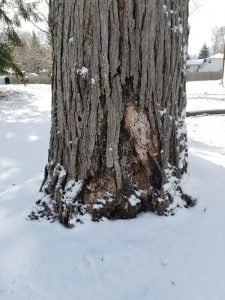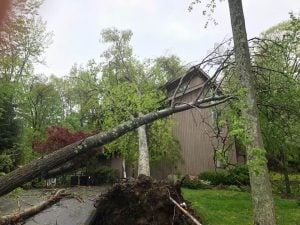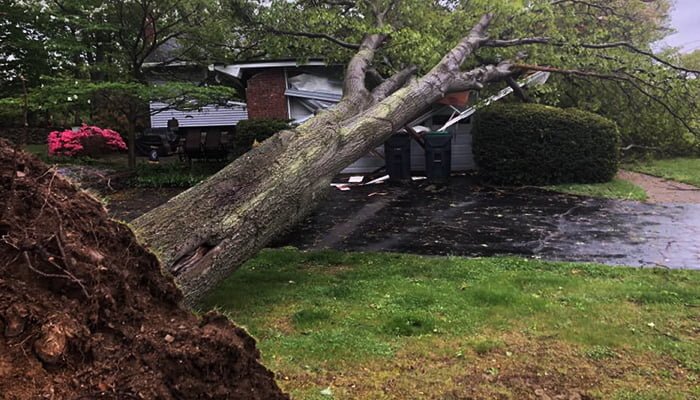Severe storms can bring about unexpected and sudden damages that are often unavoidable. However, when it comes to the trees on your property, it is important to regularly inspect them to eliminate avoidable threats of tree damage. Depending on the severity of a storm, even healthy trees can be uprooted, but, by treating trees that are weakened, you are reducing the risk of damages within your control.
There are several warning signs that there may be something wrong with your tree, some of which you can see with an untrained eye, and some that take a more skilled professional to diagnose.
 A hole in the trunk – You may see a cavity form in the trunk of your tree. This could be a sign that there is some sort of decay and that your trunk’s strength is compromised. This doesn’t always mean danger for your tree or home that is near the tree, but an inspection should be performed by a professional arborist to confirm if this tree is hazardous or not.
A hole in the trunk – You may see a cavity form in the trunk of your tree. This could be a sign that there is some sort of decay and that your trunk’s strength is compromised. This doesn’t always mean danger for your tree or home that is near the tree, but an inspection should be performed by a professional arborist to confirm if this tree is hazardous or not. - Missing bark – An area of bark that is missing or dented can be classified as a “canker”. This defect can lead to higher probability that your tree will break in this spot.
- Dead or falling branches – When a tree’s branches begin to fall, that should be a warning sign that something is wrong. Not only is this a sign that there is something wrong with your tree, but these falling branches can be a danger to you and your home.
- Leaning trunk – A leaning trunk may be an indication that the tree has already been affected by wind or root damage making is more susceptible to a fall in severe weather. However, it is important to be able to distinguish between a leaning trunk and a tree with a naturally tilted trunk.
- Losing leaves from the outside in – A tree losing leaves in a systematic way, or in a certain area likely means that there is an issue with its root zone (where the tree gets its nutrients and water).
- Rotting roots – This is one that is often hard to spot for an untrained eye. Look for warning signs like mushrooms growing around the base of the tree or mushroom growth on the tree trunk itself. Mushrooms on a tree’s trunk can be an indication that there is tree damage or rotting on the inside.
- Tight branch growth – Branches growing very close together in a V-shape is often a bad sign and can indicate weakness. Trees with less than a 45-degree angle to each other could mean a weakened branch structure and the stems will compete with each other for nutrients. The “loser” could die and fall leading to tree damage. A U-shape is a better indication of strength.
- Compromised soil – If the soil around a tree has been compromised or disturbed, this is not good for the health of your tree. If you often drive over the soil around your tree, or the soil near your tree has been disrupted by a utility line or pipe, your mature tree may be less likely to push new roots to that area, making it less stable on one side.
 Severe weather is becoming more common in our area, and because of this, it is particularly important for you to have regular inspections completed by a professional arborist to ensure that your trees are stable and healthy. If it is determined that a tree is weakened or suffering from some sort of illness, your professional can properly diagnose your tree’s issue and put together a plan to nurse it back to health. It may be determined that the best solution is to remove your tree, especially if it is close to your home. As a homeowner, you want to make sure you are avoiding tree damage whenever possible. Contact Red Cedar today for your free consultation and let us help to make sure your trees are healthy and strong. By being proactive, we can work to avoid damages associated with trees.
Severe weather is becoming more common in our area, and because of this, it is particularly important for you to have regular inspections completed by a professional arborist to ensure that your trees are stable and healthy. If it is determined that a tree is weakened or suffering from some sort of illness, your professional can properly diagnose your tree’s issue and put together a plan to nurse it back to health. It may be determined that the best solution is to remove your tree, especially if it is close to your home. As a homeowner, you want to make sure you are avoiding tree damage whenever possible. Contact Red Cedar today for your free consultation and let us help to make sure your trees are healthy and strong. By being proactive, we can work to avoid damages associated with trees.


